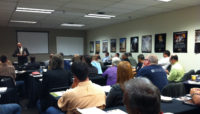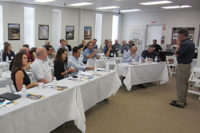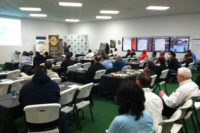Business expansion
The first education session focused on how to improve and expand a business in the face of a difficult economy.
How can you expand your business?
“You have to define what you mean by expanding,” said Tony Malisani of Malisani, Inc., and Secretary of the Marble Institute of America, who led the session. “Are you expanding capacity? Are you expanding hours? Are you investing in equipment? You need to put an actual number on what you want to achieve. It isn’t an emotional decision of ‘I just want to be bigger.’ You need to think in terms of numbers. For example, ‘If I grow 10% in volume, I would gain X.’ You need to commit to a number and assign a value to it. If you commit to a number, you will do what it takes to make it work, and there are different ways of getting there.
“You also need to look five or 10 years down the road, and think of where you want to be,” Malisani continued. “For us, we made a commitment to work with specifiers. Our company moved into terrazzo work, and we promoted to the architectural and design community. I am in an unusual situation, being in Montana with a low population, and we developed a reputation. We promote our background and our experience. You have specifiers looking to you for information.”
A number of fabricators in attendance said that they have expanded into customized, high-end stonework to get more value-added work from their customers. “Most people got into this business thinking that the market was only countertops, and for a decade and a half, it was,” said one fabricator. “But now, if you walk into our shop, we are doing a lot of other work. Countertops are only a small part of it.”
How can you better manage your business?
“Think of what is important to your success,” Malisani said. “Not every plan is right for every company. You need to think of where you want to be, and what you want to do. Are you a small, custom shop, or do you want to be a volume shop?”
One fabricator in attendance explained that he hired an administrator, and the added cost was more than offset by the fact that, as an owner, he was now free to increase revenue and expand the operation — something he was not able to do in the past. Other fabricators at the event also offered specifics on how they changed their management style in the face of a changing marketplace.
What about marketing?
“You want to create a brand, but the brand needs to fit your business,” Malisani explained. “You can’t be a high-end shop and also the $39.99-per-foot shop at the same time. Do some research to determine what the strengths of your company are, and how you want to market them.
“You also need to think about what type of marketing your clients will respond to,” Malisani said. “Everyone has a Web site, but if you have commercial clients, how important is your Web site going to be to your marketing plans?”
Does it make sense to import directly?
Answers on the topic were mixed, with about one-third of attendees stating that they import directly, but they stressed that it was critical to build relationships with overseas suppliers before diving straight in.
A number of the fabricators who are importing said they are bringing in less material from overseas, due to improved cost and selection at area distributors. “I went from importing 60 containers per year to around 10 now,” said one attendee. Another cited the costs associated with maintaining his own inventory.
How are you dealing with the new technology in the marketplace?
Once again, Malisani stressed the importance of building relationships with technology suppliers. “Nothing is going to work perfect every time,” he said. “You need to find suppliers that you can work with. You need to be comfortable with the equipment, but also with the service you are getting. Also, you need to keep in mind that you will likely have to buy more equipment down the line.”
Are you conducting regular meetings with your employees?
Most of the fabricators in attendance reported that they are participating in regular meetings on sales, general shop operations, and in particular, safety. “We have regular safety meetings, and we go through the Marble Institute of America safety materials,” explained Jon Mitnick of CCS-Stone, who has been working in the industry for more than two decades. “You really need to be prepared when it comes to safety. Then if you get a visit from OSHA, you are ready, and you can document everything.”
Practical fabricator issues
Following the collaborative session on managing a business, an afternoon Fabricator Forum was moderated by Malisani, and had a panel of three industry veterans.
• Linda Stelmaszyk of Stoneshop in Cherry Hill, NJ
• Buddy Ontra of Ontra Stone Concepts in Bridgeport, CT
• Marco Duran of Atlas Marble and Granite in Newark, NJ
The panel and audience addressed some of the practical issues faced by today’s fabricators.
Are you having problems working with quartz surfacing?
Ontra: Quartz surfacing is definitely a blade eater, because the density of the material really eats up the blades. It is also tougher to face polish.
Duran: One option is to slow down the speed of the blade. We actually cut our quartz surfacing with a waterjet.
Matt Smith, GranQuartz: If your shop doesn’t have a waterjet, or if your gantry saw only goes one speed, you can reduce the blade size, and it works similar to reducing the speed.
Malisani: We use a marble blade when we are working with quartz surfacing.
As far as the top surface goes, we let the customer feel it before we begin cutting. We want them to know what the surface finish feels like.
What about “fixing” issues with a stone during the fabrication process?
Malisani: It is OK to fix a stone if you need to, but you need to set customer expectations up front.
Ontra: We use terms like “industry standard” and “general practice” when we are talking about issues like filled fissures. They help the customer understand what to expect. Then if you exceed those standards, then you look good in the customer’s eyes.
Stelmaszyk: We equate it to working with wood. There is a difference between what it looks like in the mill, and when it is finished.
Malisani: The standard on any “fix” for us is invisible to the eye and invisible to the touch.
Duran: As a fabricator, transparency is very important. We don’t avoid discussing surface fissures or anything like that. We take the time to explain and help them understand that we are trained to work with stone and its fissures, but we are not magicians.
You have to understand that the customer is emotionally involved, not technically involved.
Malisani: We also send customers to the MIA Web site so that they can find legitimate information.
Are you having problems with exotics etching?
Duran:“Exotics” is just a marketing phrase. You need to look at the stones that contain calcium carbonate, and those are the ones that will etch. I bought a resource book on gems and minerals, and I learned to recognize what is in these different materials. It is a matter of connecting the dots. Once you learn this, the education is a great sales tool.
Ontra: Some materials may etch more than others, so you need to always be conscious of anything with acid content.
Again, this is part of customer education. When your customer comes in to do the layout, you need to point out everything. Point out where a slab was filled and treated with resin and explain why it is necessary in order to produce certain types of materials.
Stelmaszyk: Exotics also differ a lot. The problem is that the customer goes to the slab yard and chooses their product. Then the product goes to the shop and no information is passed on along the way.
Jon Mitnick, CCS-Stone: As a wholesaler, I have had shops buy a material and then come back to me and complain. At what point on a professional level do I point these things out?
Joshua Levinson, Artistic Tile: We are also a wholesaler, and we don’t proactively educate the fabricators, but they don’t reach out to us either. We have made a push to educate the architecture and design community with localized education.
Malisani: It all goes back to the process. This is why we like to ask our distributors about exotics, because if there are problems with a certain stone, they probably already heard about them. For example, we like to rod everything, but if you rod certain quartzites, you will be able to see it from the top.
We also learn little tidbits from our distributors through communication. We learned that soapstone is actually compressed talc, and that Blue Pearl granite contains shells. These are facts that you can share with your customers.
We also hand out MIA care brochures during the visit. They explain about the use of marble in kitchens and other important issues.
Duran: We have really seen an influx of stone over the past few years. When I started in this business in 1988, the suppliers knew all of their stones. Now it is much more global.
What about working with white marble?
Kim Dumais, Miller-Druck Specialty Contracting Co.: For 23 years, I have been preaching to architects, designers, etc. against using white marble. In New York, with contemporary designs, people want clean and they want polished. But maybe by bringing down the finish, you address some of the etching issues.
I actually ended up putting white marble in my own kitchen. I see rings, and they drive me wild. Meanwhile, a European client wouldn’t mind that. They know patina. But a Park Avenue client would not accept it.
It all goes back to educating the customer on finishes, grades of honing, etc. You need to know your product, and you also need to know your end user.
Ontra: I would say that nine out of 10 customers using white marble go with a honed finish, per my recommendation, but I still have them sign off on the fact that if I have to send my guy out in a year to fix something, they will pay for it.
Duran:It is also important to know that the marble sealers out there are great for blocking absorption, but not etching. I am always happy when I can find a quartzite that will give that warmth, but without the same level of etching.
Also, when you’re applying these sealers, use a brush and not a paper towel. Let your installers know, “This is where you need to take your time.”
Are you laminating quartzites? What are you using? Are you seeing a darkening of the material?
Malisani: The amount of time you allow the adhesive to dry can make it worse. A quick-drying adhesive doesn’t allow as much time for the adhesive to absorb in to the stone.
Smith: When you use a 100% solids epoxy, you are looking at a drying time of 15 minutes as opposed to 24 hours.
How do you learn how to work with some of these new materials?
Ontra: We keep it in house. I’ve experienced a lot, and really, you learn by doing. One thing we never do is use a colorant on the edges, or we will get called back.
Malisani: The MIA is actually looking into developing new training materials. One thing we always do is partner a new employee with an experienced worker.
How are people rodding their tops? Is anyone having problems with galvanized steel rods expanding and breaking the stone?
Duran: We used a threaded steel rod, and we are using flowing epoxy instead of knife-grade. People are using cheap glues, and that is a recipe for failure.
Malisani: We rod around all openings, and it is actually part of our marketing.
Stelmaszyk: One thing you want to promote is that this is not manufacturing; it is craftsmanship. Every finished product is a little different, and all of it is custom.
How are you templating?
Duran: We switched over from plywood sticks to the Laser Products LT-55 electronic templating system. We schedule up to five templating jobs per day. The set-up is quick, and it is passed onto the programmer as a DXF file.
But no matter how we are templating, it is very important that the person templating is meticulous and pays attention to detail.
Ontra: I don’t have a CNC, so I do stick templates. It avoids any conduction when you place the template directly onto the slab. The customer can see it and visualize it better.
Stelmaszyk: My husband refuses to train on anything other than physical templates. When you’re dealing with islands, for example, the homeowners can view the overhangs.
Who cleans up the file and does the offsets when you are doing digital templating?
| 2013 MIA/Stone World Industry Education Series dates released |
| The Marble Institute of America and Stone World are pleased to announce the 2013 schedule for its Stone Industry Education series. To register, visit www.stoneindustryeducation.com. |
|
February 21, 2013 - Orange, CA March 21, 2013 - Houston, TX April 18, 2013 - Columbus, OH May 16, 2013 - Boston, MA June 19, 2013 - Salt Lake City, UT July 18, 2013 - Seattle, WA September 19, 2013 - TBD October 17, 2013 - Atlanta, GA November 7, 2013 - Pompano Beach, FL |
Duran: I depend a lot on my templater. He is my quarterback. He has to make sure everything flows right.
Malisani: In a lot of smaller operations, the installer is the templater, so you have to make sure the system you are evaluating makes sense for your particular operation.
The MIA/Stone WorldIndustry Education Series will continue throughout 2013, and open fabricator forums will be a key component of these sessions. Learn more at www.stoneindustryeducation.com.






